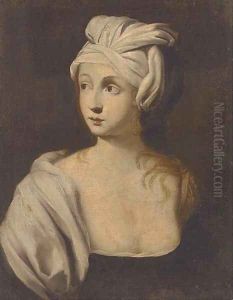Francesco Romanelli Paintings
Francesco Romanelli was an Italian painter of the Baroque period, born in 1610 in Viterbo, a city in Lazio, which is now part of modern-day Italy. He is known for his history paintings, which often incorporated themes from classical mythology and the Bible. Romanelli's work is characterized by its vibrant color palette, dynamic compositions, and the blend of classical ideals with Baroque theatricality.
Romanelli was trained by his father, Laura Romanelli, before moving to Rome to study under the tutelage of Domenichino, a prominent painter of the time who was a leading figure in the classical trend of Roman painting. Francesco’s style was also influenced by Pietro da Cortona, another distinguished Baroque artist. This exposure to various influences helped Romanelli develop a versatile style that could range from the classical to the dramatic.
In Rome, Romanelli became associated with the Barberini family, a powerful papal family that were great patrons of the arts. His work for the Barberini family included decorations for their palaces and for the Vatican. One of his most notable works for the Barberini was a series of tapestry designs illustrating the life of Christ and the Virgin, which were woven in the Barberini tapestry workshop.
Romanelli's career flourished under the patronage of Pope Urban VIII and his nephew, Cardinal Francesco Barberini. However, when Pope Innocent X Pamphili succeeded to the papacy, the Barberini family fell out of favor, and Romanelli's fortunes waned. He left Rome for a period, accepting commissions in France, where he worked for the court of King Louis XIV, creating works for the Louvre and other royal residences. His time in France was marked by significant success, and he was well-received by the French aristocracy.
Upon his return to Rome, Romanelli continued to receive commissions, but he never regained the prominence he had enjoyed under the Barberini patronage. He passed away in 1662 in Rome. His legacy includes his influence on later artists, both in Italy and France, and his contributions to the development of Roman Baroque painting. Romanelli's works are held in various collections and can be seen in churches and museums across Italy and France.
